- By Joe Fylan
- February 10, 2021
Bluehost are one of the biggest names in shared hosting — and DreamHost aren’t far behind. Both have been around since at least 2003, and host millions of websites for their customers, so, if you’re looking for excellent-value shared hosting, these are two companies you’re likely to be considering.
But are they any good? And, if so, which one should you choose?
In this comparison, I’ll look at the most important features of their shared hosting plans and highlight their main differences. Most importantly, I’ll also use paid tools to measure the performance of the shared hosting plans to give you an idea of how fast your website will load, how many visitors it can handle at once and what amount of downtime you might experience.
Whether you’re planning to start a new website or you’re thinking of changing hosts, this comparison will help you to decide if you should sign up with Bluehost or DreamHost — or continue looking.
Let’s begin…
Bluehost vs DreamHost Shared Hosting Plan Details
Founded in 2003, Bluehost have a reputation for providing some of the most affordable and feature-rich hosting plans around. However, DreamHost, which started out in 1997, have plans that are even more affordable — while still managing to offer a comparable set of features.
All of the shared plans from both hosts include unlimited or unmetered bandwidth, while all but their entry-level plans give you unlimited storage to work with and the ability to create an unlimited number of websites.
You’ll have to stick to the Bluehost and DreamHost usage policies that define exactly what unlimited means, but, for most people, that shouldn’t be a problem.
While both Bluehost and DreamHost have WordPress-only plans, the lower-priced entry-level shared plans I’m comparing here make it very easy to launch and manage WordPress websites.
So, to get started, let’s take a look at the details of their different plans before exploring the main features in more depth.
Bluehost Shared Hosting Plans
 The entry-level Bluehost shared plan is currently reduced to $2.95 a month.
The entry-level Bluehost shared plan is currently reduced to $2.95 a month.With prices that currently start from just $2.95 a month, the Bluehost shared plans are definitely one of the most affordable ways to start a new website:
- Basic: From $2.95 a month for one website with 50 GB of storage and standard performance.
- Plus: From $5.45 a month for unlimited websites with unlimited storage and standard performance.
- Choice Plus: From $5.45 a month for unlimited websites with unlimited storage, plus a one-year CodeGuard Basic subscription and standard performance.
- Pro: From $13.95 a month for unlimited websites with unlimited storage, plus a full-term CodeGuard Basic subscription, dedicated IP and optimized performance.
I’ll explore the main features of these plans throughout this comparison, but the CodeGuard subscription that comes with the Choice Plus and Pro plans includes automatic website backups and some useful security tools.
Unlike DreamHost shared hosting, Bluehost give you the option of unlocking higher performance by choosing their most expensive Pro plan. However, for the site speed and load handling tests in this comparison, the standard performance Plus plan was used.
If you change your mind after signing up with Bluehost, you can get a refund if you cancel your account within 30 days.
You can view the full details and differences of these plans on the Bluehost shared hosting page.
DreamHost Shared Hosting Plans
 The DreamHost shared hosting plans currently start at $2.59 a month.
The DreamHost shared hosting plans currently start at $2.59 a month.With DreamHost, you get just two shared hosting plans to choose from:
- Shared Starter: From $2.59 a month for one website and 50 GB of storage.
- Shared Unlimited: From $3.95 a month for unlimited websites and unlimited storage.
The main deciding factor when choosing a plan from DreamHost will probably be how many websites you’d like to host. There are a few other differences between the DreamHost shared hosting plans, such as whether or not an email service is included and how many MySQL databases you can create.
I’ll cover exactly what else you get on the plans and see how they compare with Bluehost throughout this comparison.
Suggesting high levels of confidence in their service, DreamHost have an impressive 97-day money-back guarantee in place that enables you to get a full refund if you cancel your shared hosting plan within this period.
For the full details of the two plans, check out the shared hosting page on the DreamHost website.
Promotional Rates
The prices listed above are the promotional rates, and, at the time of writing, they were the lowest prices you could pay when purchasing a new plan from DreamHost or Bluehost and paying for 36 months of hosting upfront.
If you prepay for less than three years, your hosting fees will be higher, depending on the length of your contract. Also, when the period of hosting you’ve paid for up front is over, you’ll pay a higher rate to renew your plan.
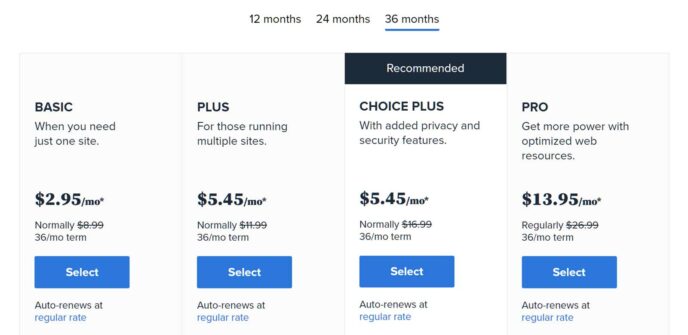 The price of the Bluehost (pictured) and DreamHost plans are reduced for new customers.
The price of the Bluehost (pictured) and DreamHost plans are reduced for new customers.As the renewal rates can be quite a bit higher than the promotional rates, be sure to take them into account when deciding which plan you can afford.
The Bluehost website has full details of their regular rates, but renewal rates of the DreamHost plans aren’t as clearly published. Currently, though, the price of the DreamHost plans go up to $11.99 a month, depending on which one you choose and how long you pay for in advance.
 The DreamHost plans are currently reduced, and these lower rates are available if you choose the prepaid option.
The DreamHost plans are currently reduced, and these lower rates are available if you choose the prepaid option.Considering the top-level Shared Unlimited plan from DreamHost isn’t much more than the price of the entry-level Basic plan from Bluehost, DreamHost look like the best value option here. However, don’t make a decision just yet, as there’s more to consider than price when deciding whether Bluehost or DreamHost are the right shared host for you.
Shared Hosting Feature Comparison
As well as the unlimited storage and bandwidth allowances of most of the Bluehost and DreamHost shared plans, there are more reasons to consider these two hosts. Here are some of them…
Domains and SSL Certificates
 Both hosts provide easy access to free SSL certificates to keep your website secure.
Both hosts provide easy access to free SSL certificates to keep your website secure.Both hosts provide you with a free one-year domain name registration if you sign up and pay up front for 12 months or more of hosting. Depending on which domain extension you choose — for example, .com, .net, etc. — this could save you around $10 to $15.
However, after the first year, you’ll have to pay an annual renewal fee to either Bluehost or DreamHost to keep your domain. As the renewal fees from Bluehost and DreamHost could be more than you’d pay if you registered your domain elsewhere, it’s worth checking the full details to see if taking the hosts up on this offer is the most cost-effective option in the long term.
As well as a domain name, your website will also need an SSL certificate to keep it secure. With that in mind, it’s great to see both hosts make it very easy to apply a free SSL certificate from Let’s Encrypt to your website. If you don’t want to use the free SSL certificate, you can purchase one from either host or elsewhere, and then apply it to your site.
As we saw in our GoDaddy vs Bluehost comparison, not all hosts make it this easy to apply a free SSL certificate to your site.
Verdict: It’s a draw, as both hosts provide you with a free domain and make it easy to apply an SSL certificate.
Website and Account Backups
To ensure you won’t lose any data if anything goes wrong, your account and its content is automatically backed up each day with DreamHost. If you need to restore a backup, you’ll then have access to a snapshot of your account that’s less than 24 hours old.
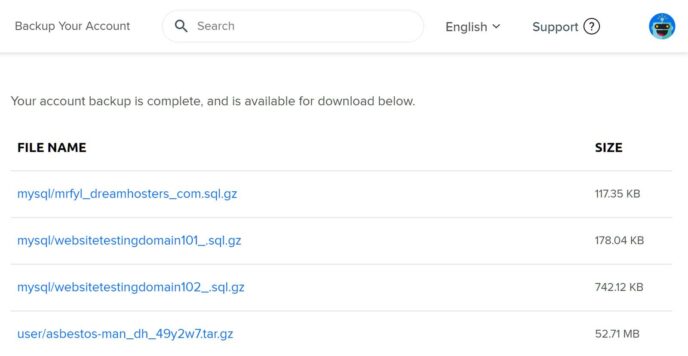 DreamHost automatically back up customer accounts every day.
DreamHost automatically back up customer accounts every day.DreamHost also provide you with a free subscription for the Total Upkeep WordPress plugin, worth $5 a month. Because of this, you’ll get access to a powerful WordPress website backup tool that gives you more control over your backups, including restoring individual files and viewing recent changes to your site.
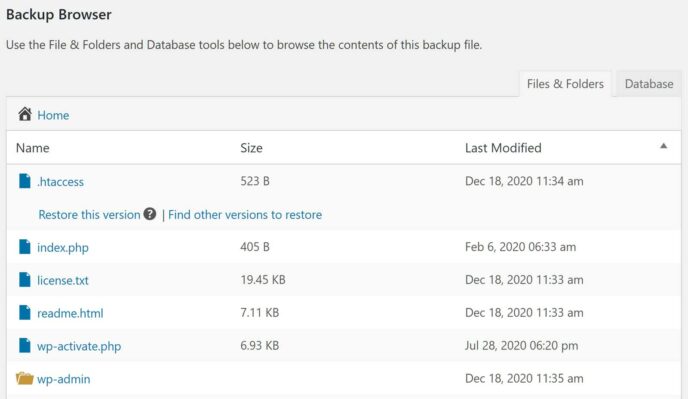 The DreamHost shared hosting plans come with a subscription to the premium Total Upkeep WordPress backup tool.
The DreamHost shared hosting plans come with a subscription to the premium Total Upkeep WordPress backup tool.With Bluehost, the two lower-priced shared hosting plans — Basic and Plus — only give you the ability to manually create and restore account and website backups via cPanel. If you want automatic daily backups, you’ll need to choose one of the two top-tier plans — Choice Plus and Pro — as they come with a subscription to CodeGuard, a tool with a backup feature.
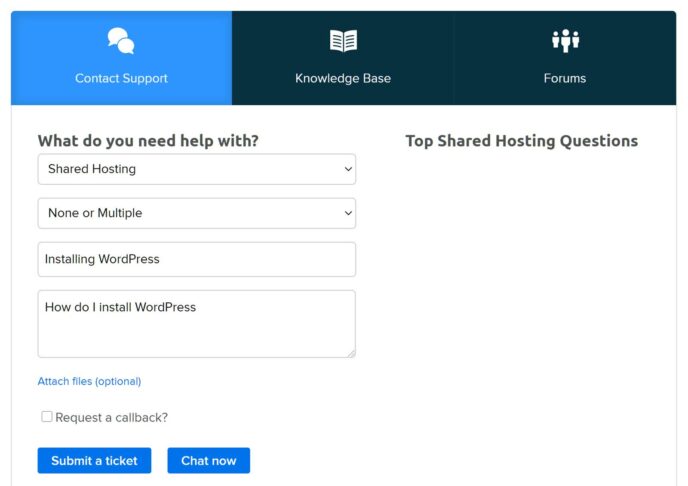 The two top-tier Bluehost plans include daily backups via a CodeGuard subscription.
The two top-tier Bluehost plans include daily backups via a CodeGuard subscription.However, the Bluehost Choice Plus plan only includes a one-year CodeGuard subscription, compared with the ongoing subscription of the Pro plan. You also have the option of paying to add CodeGuard to the lower-priced plans, with the entry-level plan starting at $2.99 a month.
If you’re going to be using WordPress, both hosts let you install your choice of backup plugin, including free options such as UpdraftPlus.
Verdict: DreamHost win here as they provide automatic daily backups on all of their plans, plus access to a premium WordPress backup tool, whereas Bluehost reserve these features for their more expensive shared hosting plans.
WordPress Features
As mentioned, both hosts also offer WordPress-only plans, including premium managed WordPress hosting. You can find out more about these premium plans in our Bluehost managed WordPress hosting review and our DreamHost DreamPress review.
However, their shared plans include some useful features WordPress users will appreciate, which I’ll quickly explore now.
Automatic WordPress Installation
To help you to get your new site up and running as quickly as possible, you can have WordPress automatically installed during sign up with both hosts. If you need to install WordPress at a later date, the process is very straightforward.
WordPress Website Setup Wizards
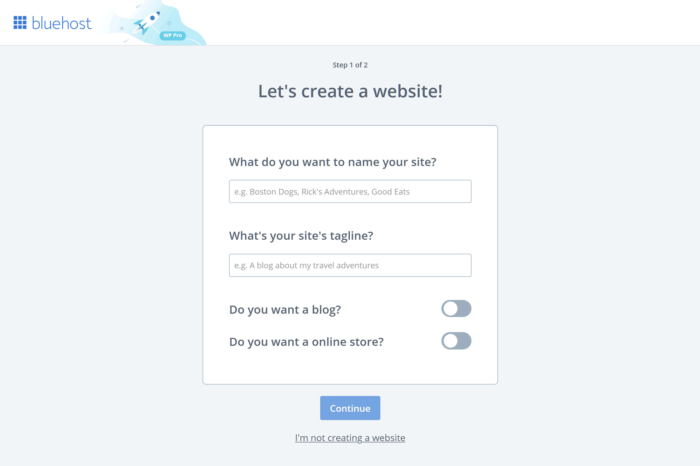 Both hosts have wizards what will hep you to build a WordPress website.
Both hosts have wizards what will hep you to build a WordPress website.To help you to set up your new WordPress website, both hosts have optional wizards that walk you through the essential steps involved in starting a new site, such as creating your first pages, choosing a theme and installing some of their recommended plugins.
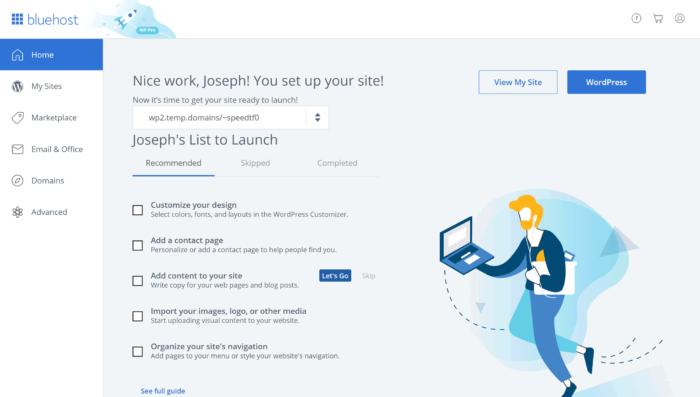 Bluehost have a checklist to walk you through setting up a website.
Bluehost have a checklist to walk you through setting up a website.Bluehost also have their Blue Flash service that entitles new customers to schedule a free call with the support staff, where they’ll be assisted with creating their new website. If you’re holding back on starting a new site because you’re not sure if you have the skills to complete the task, this feature should be of interest.
To enhance the standard WordPress experience, Bluehost have recently launched a marketplace that enables their customers to purchase and install premium themes and plugins through their WordPress dashboard.
 DreamHost customers get free access to premium themes from BoldGrid.
DreamHost customers get free access to premium themes from BoldGrid.DreamHost have a similar feature that’s available as part of their collaboration with BoldGrid. As well as the WordPress startup wizard, this integration provides you with access to a website builder and a selection of premium themes and plugins.
Automatic WordPress Updates
The latest versions of WordPress can now be set to automatically update the WordPress software, themes and plugins on your site. However, both hosts have a few extra update-related features to keep your site safe and secure.
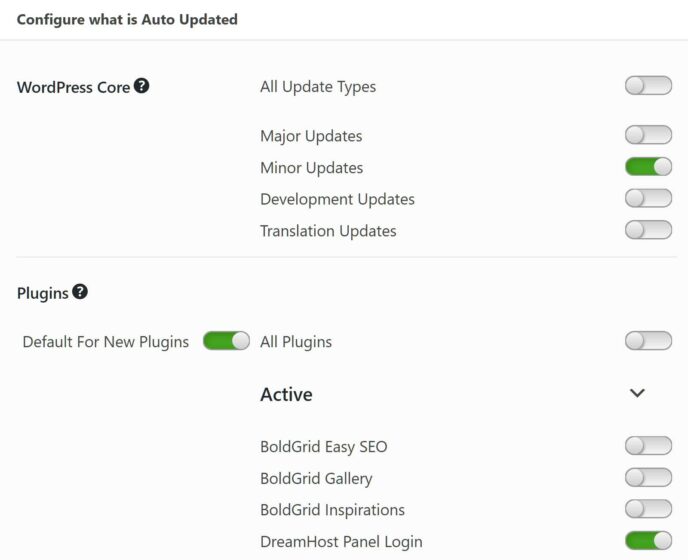 Total Upkeep, which comes with the DreamHost plans, includes advanced WordPress update features.
Total Upkeep, which comes with the DreamHost plans, includes advanced WordPress update features.For example, the Total Upkeep plugin that comes with the DreamHost shared plans (and is available separately) will automatically create a backup of your site before an update is installed. If something goes wrong with the update, Total Upkeep will automatically restore the backup to avoid any disruption being caused. Total Upkeep also gives you more granular controls over how and when updates are applied to your site, compared with the default WordPress experience.
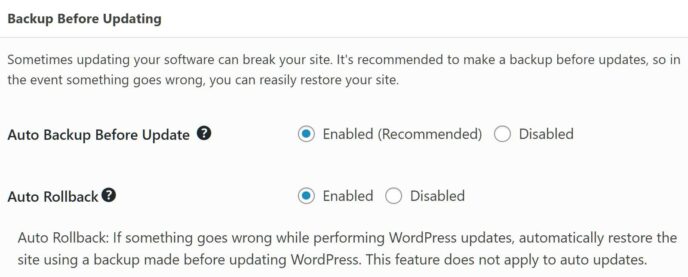 The Total Upkeep tool that’s provided by DreamHost will back up your site before updating it.
The Total Upkeep tool that’s provided by DreamHost will back up your site before updating it.With Bluehost, you can either enable or disable updates for WordPress software, as well as for themes and plugins, rather than setting them at an individual level. However, as mentioned, now that the latest versions of WordPress includes configurable automatic updates, and there are also free plugins that have this functionality, this shouldn’t be a deal-breaker.
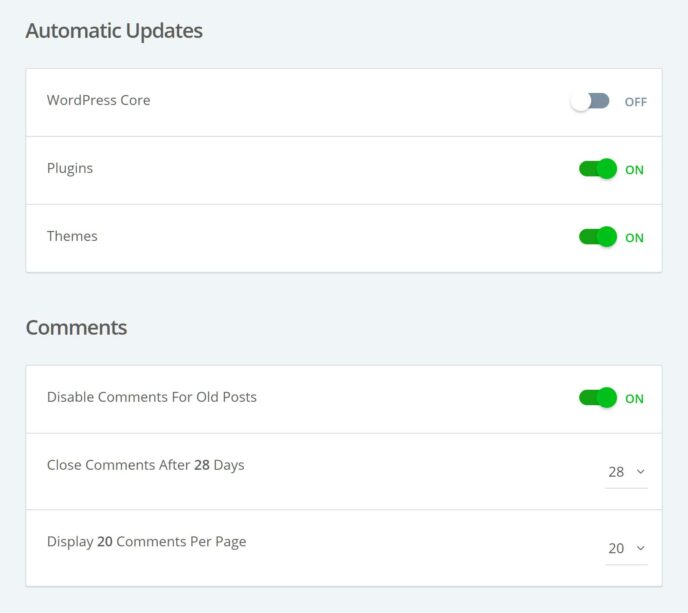 You can control WordPress auto updates through the Bluehost dashboard.
You can control WordPress auto updates through the Bluehost dashboard.WordPress Staging
If you want to try a new plugin, theme or some custom code on your WordPress website, a safe way to do so is to create a staging environment. This approach enables you to quickly and easily make a private copy of your site where you can safely test out these changes. Then, once you’re ready, you can transfer those changes to your live site, usually at the touch of a button.
Bluehost shared hosting customers get access to a pretty useful staging tool. Not only does it make it easy to create the staging site, but you can also copy the entire site, including its files and database, or just the files or database.
Unfortunately, the DreamHost shared hosting plans don’t include a staging tool, and instead recommend you manually create a staging site yourself. There are also plugins that can help with creating a copy of your site.
Verdict: When it comes to WordPress features, it’s a draw, as both hosts make it very easy to create WordPress websites on their shared plans, thanks to the auto-installers and wizards. DreamHost have better WordPress updates and backup features, while Bluehost have a staging tool.
User Support
You can contact the support staff at both hosts via live chat 24/7, and, during testing for this comparison, both hosts were responsive and helpful via this channel. However, as I didn’t run into any major problems, and my interactions were mainly regarding queries I had about the service, I can’t say how good either host would be in a crisis.
As well as live chat, Bluehost will also let you call the help desk via their US and international telephone numbers. DreamHost only give you the option of requesting a call back from the support staff. Furthermore, you have to pay to request a callback, with prices starting at $9.95.
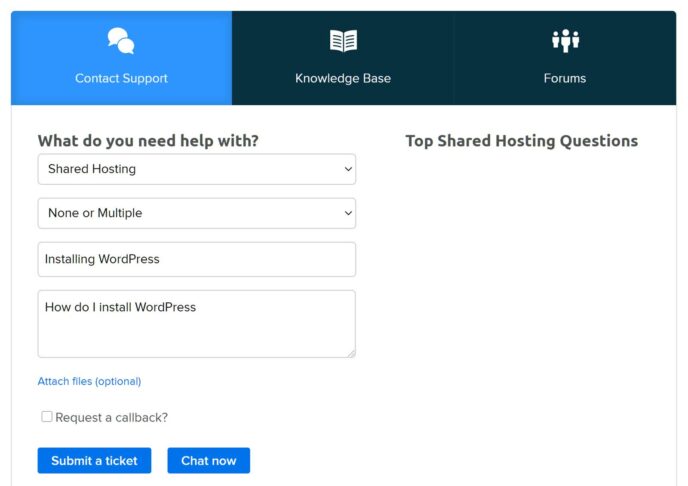 With DreamHost, you can contact support by starting a live chat session or submitting a ticket.
With DreamHost, you can contact support by starting a live chat session or submitting a ticket.Unlike Bluehost, DreamHost do give you the option of submitting a ticket. They also make it easy to access the logs of previous live chat sessions through your account area. There’s a DreamHost discussion forum, too.
If you plan to use WordPress and would like extra help, you may be interested in the Bluehost BlueSky premium support service. Another option is to sign up with a third-party WordPress maintenance service if you’d like someone to take care of looking after your site.
Verdict: If you want to be able to contact support via telephone, and don’t want to pay extra for it, Bluehost are the winner. However, if being able to submit tickets to the help desk is more important, DreamHost are likely to be the better option for you.
Now that I’ve covered and compared the main features of the Bluehost and DreamHost shared hosting plans, it’s time to see what sort of performance you can expect from both hosts.
Bluehost vs DreamHost Performance Tests
With similarly priced plans, you may not be expecting much difference in performance from the Bluehost and DreamHost shared hosting.
However, as the performance tests reveal, you could get a significantly faster site by choosing one of these hosts over the other.
As well as monitoring the speed of the test sites hosted by Bluehost and DreamHost, I also used a load handling service to see what happened when multiple people accessed them at the same time. Uptime was also monitored to detect any downtime.
Here are the results…
Load Time Testing
To find out how fast websites load when they’re hosted on the Bluehost and DreamHost shared plans, I created four test sites and then used Pingdom to monitor their speed. Pingdom recorded the load time every 30 minutes for seven days to find the average speed for each site.
As the test sites were built using WordPress with lightweight and heavyweight themes installed, you can see how fast your site may load depending on what type of website you want to create.
For the first set of tests, WordPress websites using a lightweight theme with a simple design were monitored.
Lightweight Theme Speed Test Results
If you’re going to be creating a personal blog or relatively simple business website, then you may want to choose a free lightweight theme, such as the popular Twenty Twenty.
 Twenty Twenty is a popular example of a lightweight WordPress theme.
Twenty Twenty is a popular example of a lightweight WordPress theme.Keeping things simple with a theme such as this not only makes it easier to build your site, but it should also load faster compared with using a more heavyweight theme.
To find out exactly how fast, I created two WordPress websites using the Twenty Twenty theme that were as identical as possible. Next, I published a basic blog post that contained some text and an image on each site. Pingdom was then set to monitor the speed of that blog post.
Bluehost Lightweight Theme Speed Test Results
For the site hosted by Bluehost, the average load time for that blog post was 1.17 seconds.
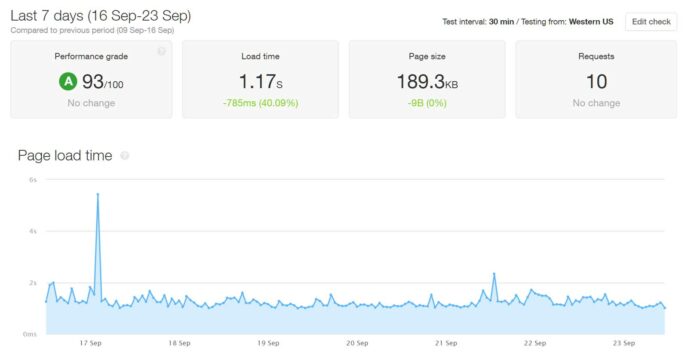 The site hosted by Bluehost using the lightweight theme had an average load time of 1.17 seconds.
The site hosted by Bluehost using the lightweight theme had an average load time of 1.17 seconds.DreamHost Lightweight Theme Speed Test Results
For the same blog post on a site configured in the same way, but this time hosted by DreamHost, the average load time was a much faster and more impressive 353 milliseconds or 0.353 seconds.
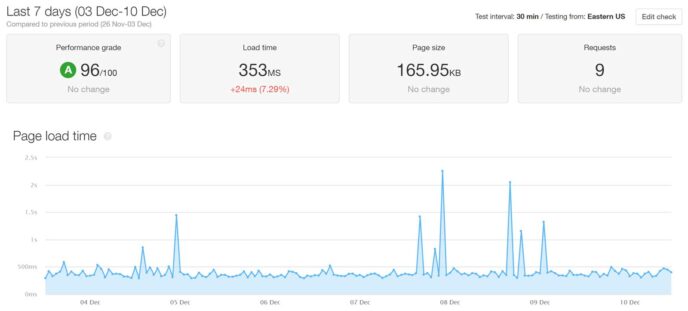 The site hosted by DreamHost using the lightweight theme had an average load time of 353 milliseconds.
The site hosted by DreamHost using the lightweight theme had an average load time of 353 milliseconds.Lightweight Theme Speed Test Results Summary
As you can see, the WordPress website with the lightweight Twenty Twenty theme installed hosted by DreamHost was more than three times faster than the same site hosted by Bluehost.
 Summary of the load times of the sites using a lightweight theme.
Summary of the load times of the sites using a lightweight theme.If you plan to create a simple blog, then achieving a load time of less than half a second that DreamHost delivered is sure to keep your visitors happy.
Heavyweight Theme Speed Test Results
Not everyone wants to use a lightweight theme or create a relatively simple website. So, if you’d rather build a more advanced website, then a heavyweight theme may be your preferred option.
Avada is a great example of a heavyweight theme. Not only is it one of the best-selling WordPress themes of all time, it’s packed with features and prebuilt website content.
 Avada is a best-selling multipurpose WordPress theme.
Avada is a best-selling multipurpose WordPress theme.So, to help you to get an idea of what loading times you might expect from Bluehost and DreamHost if you build a more advanced website using videos, sliders and lots of images, I installed the Avada theme on the test WordPress websites and imported its Agency demo.
Bluehost Heavyweight Theme Speed Test Results
As the pages have larger file sizes and contain more elements when using a heavyweight theme, it’s no surprise to see slower loading times compared with the previous tests.
For the homepage of the site built using Avada and hosted by Bluehost, the average load time was 4.85 seconds.
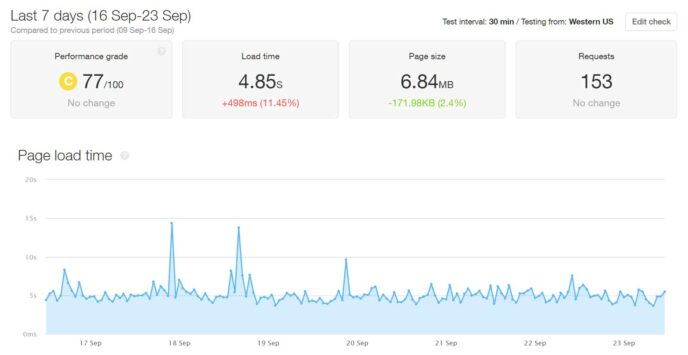 The site hosted by Bluehost using the heavyweight theme had an average load time of 4.85 seconds.
The site hosted by Bluehost using the heavyweight theme had an average load time of 4.85 seconds.DreamHost Heavyweight Theme Speed Test Results
For the same site, but hosted by DreamHost, the average load time was much faster at 2.11 seconds.
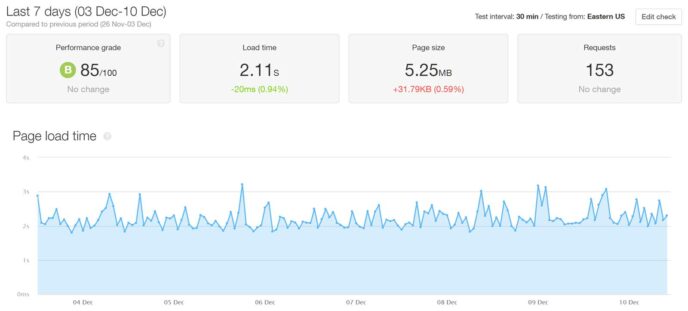 The site hosted by DreamHost using the heavyweight theme had an average load time of 2.11 seconds.
The site hosted by DreamHost using the heavyweight theme had an average load time of 2.11 seconds.Heavyweight Theme Speed Test Results Summary
As you can see, in the heavyweight theme speed test, the site hosted by DreamHost was just over twice as fast as the same site hosted by Bluehost.
 Summary of the load times of the sites using a heavyweight theme.
Summary of the load times of the sites using a heavyweight theme.Bluehost vs DreamHost Load Time Summary
Based on these results, whether you plan to create a simple website or build something more advanced, you’ll get faster loading times from DreamHost than Bluehost.
When using a lightweight theme, the site hosted by DreamHost was 231 percent faster than the same site hosted by Bluehost. In the second test, when a heavyweight theme was used, DreamHost was 129 percent faster than Bluehost.
 A summary of the load times of the test sites hosed by Bluehost and DreamHost.
A summary of the load times of the test sites hosed by Bluehost and DreamHost.While the 1.17 second load time of the site hosted by Bluehost using the lightweight theme was acceptable, the 4.85 seconds that was recorded when the heavyweight theme was used was too slow.
Because of this, if you plan to create a website with a simple design, using either DreamHost or Bluehost should be fine, but you’ll get faster times from the former.
For those who plan to use a theme such as Avada, or build a site with a more feature-rich or complex design, DreamHost are recommended over Bluehost when it comes to loading times.
Regardless of what type of site you’re going to build, if you don’t want to keep your audience waiting around, DreamHost are the recommended option.
However, as the test sites don’t receive any traffic, these load time tests don’t tell the full story. In the next set of tests, I find out how the Bluehost and DreamHost shared plans handle surges in traffic, and what impact this has on their response times.
Bluehost vs DreamHost Load Handling Test Results
To get an idea of what’ll happen when your website is popular and your audience grows, I used the K6 (formerly Load Impact) service to simulate multiple visitors accessing the test sites at the same time.
During the tests, K6 increased the number of simultaneous virtual users accessing the sites while also recording their response times.
As you can see, the previous Pingdom tests measured page load times, while these K6 tests measure responsive times. Although there’s a difference between load times and response times, it’s safe to assume that the more the response times increase during the load handling tests, the greater the impact multiple visitors to your site will have on site speed.
As in the Pingdom load time tests, I used K6 to test the performance of WordPress websites using lightweight and heavyweight themes.
Lightweight Theme Load Handling Test Results
The site hosted by Bluehost using the lightweight Twenty Twenty theme did very well in the load handling test.
Although the response time did fluctuate during the test — as you can see from the blue line on the graph below — it never exceeded 300 milliseconds. By the end of the test, when there were 99 virtual users simultaneously accessing the site, the response time was a very impressive 84 milliseconds.
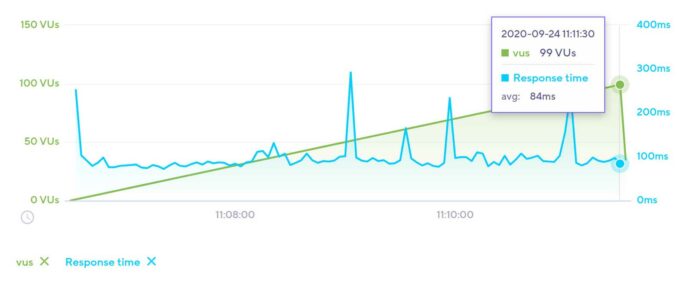 The site hosted by Bluehost using a lightweight theme performed very well in the load impact test.
The site hosted by Bluehost using a lightweight theme performed very well in the load impact test.Unlike the test site hosted by Bluehost, the response time of the site on the DreamHost shared hosting plan did increase as the number of virtual users accessing it at the same time increased.
As the graph below shows, as the number of simultaneous virtual users (grey line) reached 47, the response time (blue line) exceeded one second and continued to rise until the end of the test.
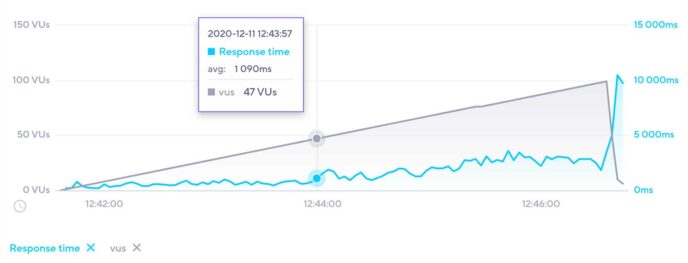 Unlike with Bluehost, the response times of the site hosted by DreamHost did increase.
Unlike with Bluehost, the response times of the site hosted by DreamHost did increase.Heavyweight Theme Load Handling Test Results
While the test sites using a lightweight theme were able to handle up to a hundred virtual users at the same time, this wasn’t the case for the test sites that had the heavyweight Avada theme and its Agency demo imported.
Because of this, the maximum number of simultaneous virtual users was reduced, and the tests were rerun.
For the site hosted by Bluehost, the response time hit 1.9 seconds by the time there were just six virtual users accessing it. The response time continued to rise, and, by the end of the test, when the number of simultaneous virtual users had reached 14, the response time was around 7.5 seconds.
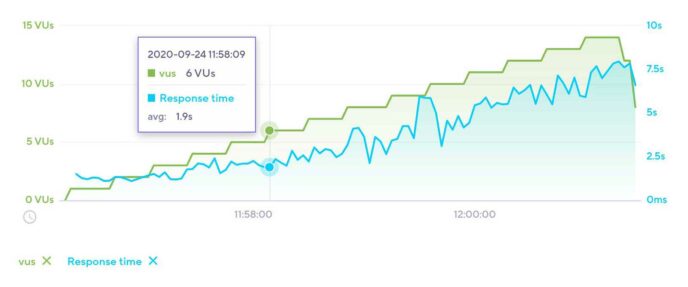 The response time of the site hosted by Bluehost reached 1.9 seconds when there were just six users accessing it.
The response time of the site hosted by Bluehost reached 1.9 seconds when there were just six users accessing it.For the same site configuration hosted by DreamHost, the response time hit 2.06 seconds when the number of simultaneous virtual users reached 18.
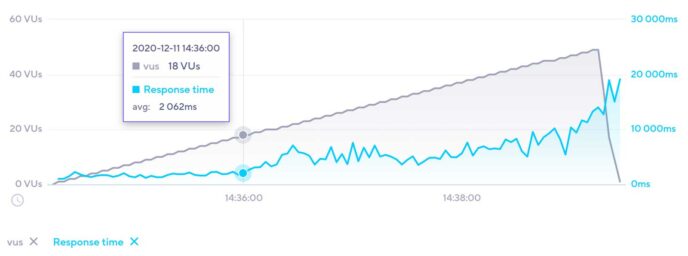 The response time of the site hosted by DreamHost reached 2.06 seconds when there were 18 users accessing it.
The response time of the site hosted by DreamHost reached 2.06 seconds when there were 18 users accessing it.Load Handling Test Results Summary
While Bluehost performed better than DreamHost in the K6 load handling tests when a lightweight theme was installed, the opposite was true when a heavyweight theme and one of its demos was used.
Although Bluehost did perform better than DreamHost when a lightweight theme was used, both hosts still did well in this test. As the response time of the site hosted by DreamHost remained under one second until 47 virtual users were accessing it at the same time, unless you expect to receive a lot of traffic, your site should still perform well if you choose DreamHost.
For the tests of the sites with a more complex design, built using the heavyweight Avada theme and one of its demos, both hosts struggled to deliver acceptable response times — even when the number of simultaneous virtual users was relatively low.
Therefore, if you expect your site to get busy, it’s best to keep the design simple if you plan to choose a shared hosting plan from Bluehost or DreamHost.
If you’re looking for a shared host that performed very well in these K6 load handling tests, regardless of what theme was used, the results from our SiteGround review should be of interest.
Bluehost vs DreamHost Uptime Monitoring
The availability of the four sites hosted by Bluehost and DreamHost was also monitored by Pingdom.
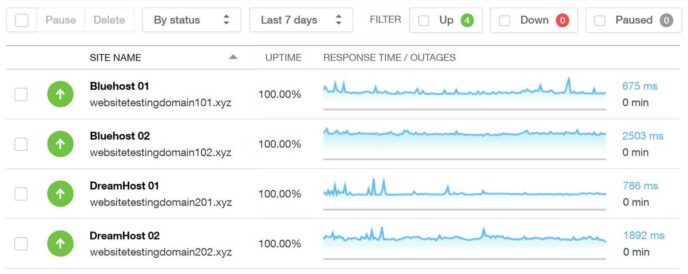 Pingdom didn’t detect any downtime for the sites hosted by Bluehost and DreamHost.
Pingdom didn’t detect any downtime for the sites hosted by Bluehost and DreamHost.While DreamHost have a 100% uptime guarantee, Bluehost don’t offer any uptime guarantees at all. However, during my tests, no downtime was detected by Pingdom during the seven days of monitoring.
Before I get to the conclusion, here’s an overview of the technical details of the Bluehost and DreamHost shared hosting services.
Bluehost vs DreamHost Shared Hosting Technical Details Overview
To answer any more questions you may have about the shared hosting from Bluehost and DreamHost, here are some of the technical details of the plans:
- Website caching: For WordPress users, Bluehost provide an in-house Endurance Cache service, which has three levels of caching, while DreamHost recommend the popular WP Super Cache plugin. DreamHost shared plans use the OPCache engine for caching websites that use PHP, such as WordPress websites.
- Content Delivery Network (CDN): Both DreamHost and Bluehost support integration with the free and paid Cloudflare plans, as well as integration with other CDNs.
- PHP: You can choose from a range of PHP versions between 7.0 and 7.4 through a web interface with both hosts.
- HTTP/2.0: HTTP/2.0 is enabled on the Bluehost and DreamHost shared plans.
- SSL: Customers of both hosts can easily apply a free Let’s Encrypt SSL certificate, import their own certificate or purchase a different certificate from Bluehost and DreamHost.
- SFTP: Both hosts let you access your webspace for uploading and editing files via Secure FTP.
- Server file manager: You can access your server space via a browser-based file manager with Bluehost and DreamHost.
- Database access: You can create and access databases with both hosts via phpMyAdmin through a browser.
- Email service: Bluehost shared hosting plans including an email service with webmail, POP3, and SMTP and support. The DreamHost Starter plan doesn’t include email repair but the Unlimited plan does. DreamHost Starter customers can add email to their plan for a small recurring fee.
- WordPress website management: Both hosts offer optional automatic WordPress software, plugin and theme updates.
- Plugin restrictions: Neither host disallow the use of any plugins, unlike some managed WordPress hosts.
- Security measures: Both hosts monitor their networks for attacks as standard. They both also offer paid security add-ons (SiteLock from Bluehost and DreamShield from DreamHost) that include daily malware scans, automatic malware removal and other security features.
- Post-hack clean-up services: The shared hosting Bluehost plans don’t include fixes for hacked sites, although the optional paid SiteLock add-on can help with this. DreamHost have a paid Hacked Site Repair service, and their DreamShield paid add-on can help with this, too.
- Data center locations: Bluehost only have one data center, which is located in Utah, western USA, whereas DreamHost have two US data centers, which are located in Virginia and Oregon.
- Staging sites: The Bluehost shared plans include access to a WordPress staging tool, but the DreamHost shared plans do not.
- WordPress website migration: Bluehost will migrate one WordPress website for free, while DreamHost charge a fee for this, but you also have the option of using their free migration plugin.
- Uptime checks and guarantee: Both hosts monitor their servers for downtime, but not individual customer websites. Bluehost, unlike many other web hosts, do not have an uptime guarantee, but DreamHost have a 100% uptime guarantee.
- Support channels: Both hosts offer 24/7 support via live chat on their shared hosting plans. With Bluehost, you can call the support staff directly, while with DreamHost you can pay to request a callback.
You can view all of the rest of the details of the shared hosting plans from these hosts on the Bluehost and DreamHost websites.
Final Thoughts
Bluehost and DreamHost certainly have some of the most affordable shared hosting plans available today.
It’s true these plans are lacking some of the features found elsewhere, such as no automatic backups from Bluehost (except on their more expensive shared plans) and no staging tool from DreamHost. However, they do include all of the essentials, such as a free domain name registration and a good set of WordPress-focused features.
However, the main difference between the two hosts can be seen in the performance tests.
The DreamHost shared hosting plans are cheaper than those from Bluehost and their load times are faster.
In fact, if you plan to use a heavyweight theme or build a complex website, Bluehost may just be too slow, with DreamHost being the only realistic option here.
When it comes to making a decision on which host to choose, unless one of the features Bluehost have that DreamHost don’t is a deal-breaker, such as telephone support or staging, then it makes sense to sign up with DreamHost. Not only will you save money, but you should also end up with a faster-loading website.
Used/using either of these two hosts? Thoughts and experiences?
Joe is an experienced WordPress user who enjoys sharing the tips and knowledge he’s picked up from using this fantastic platform for many years. You can find out more about Joe on his website.
Keep reading the article at WinningWP. The article was originally written by Joe Fylan on 2021-02-10 08:39:21.
The article was hand-picked and curated for you by the Editorial Team of WP Archives.

